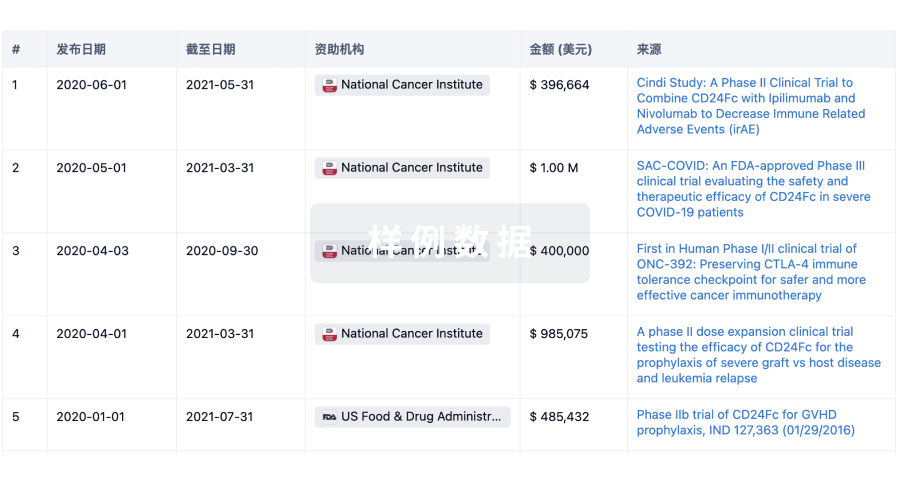预约演示
更新于:2025-09-09

Northwest Minzu University
更新于:2025-09-09
概览
标签
呼吸系统疾病
感染
预防性疫苗
多价疫苗
关联
2
项与 西北民族大学 相关的药物靶点- |
作用机制 免疫刺激剂 |
原研机构 |
在研适应症 |
非在研适应症- |
最高研发阶段批准上市 |
首次获批国家/地区 中国 |
首次获批日期2025-07-08 |
靶点- |
作用机制 免疫刺激剂 |
原研机构 |
非在研适应症- |
最高研发阶段批准上市 |
首次获批国家/地区 中国 |
首次获批日期2020-02-25 |
6
项与 西北民族大学 相关的临床试验ChiCTR2400090214
The effect of yak milk on the blood microbiome in healthy volunteers
开始日期2024-10-07 |
申办/合作机构 联勤保障部队第九四〇医院 [+2] |
CTR20240729
四价流感病毒裂解疫苗(MDCK细胞)接种于6月龄及以上健康人群的安全性、耐受性及初步探索免疫原性的单中心、盲法、安慰剂与阳性疫苗平行对照设计的Ⅰ期临床试验
主要目的:
四价流感病毒裂解疫苗(MDCK细胞)在6月龄及以上健康人群中接种的安全性。
次要目的:
四价流感病毒裂解疫苗(MDCK细胞)在6月龄及以上健康人群中接种的免疫原性。
探索性目的:
探索3~8岁人群以2种免疫程序接种四价流感病毒裂解疫苗(MDCK细胞)的免疫原性。
开始日期2024-03-30 |
申办/合作机构  浙江天元生物药业有限公司 浙江天元生物药业有限公司 [+2] |
CTR20233159
评价四价流感病毒裂解疫苗(MDCK细胞)接种于3周岁及以上人群的免疫原性和安全性的随机、双盲、同类疫苗对照Ⅲ期临床试验
评价四价流感病毒裂解疫苗(MDCK细胞)接种于3岁及以上人群免疫原性和安全性的随机、双盲、同类疫苗对照的Ⅲ期临床试验
开始日期2023-09-30 |
申办/合作机构  兰州百灵生物技术有限公司 兰州百灵生物技术有限公司 [+2] |
100 项与 西北民族大学 相关的临床结果
登录后查看更多信息
0 项与 西北民族大学 相关的专利(医药)
登录后查看更多信息
1,200
项与 西北民族大学 相关的文献(医药)2025-12-31·Cell Adhesion & Migration
N-Acetylcysteine relieving hydrogen peroxide-induced damage in granulosa cells of sheep
Article
作者: Huo, Shengdong ; Zhao, Bingzhu ; Ding, Xiaona ; Yingpai, Zhaxi ; Chen, Hao ; Zhang, Taojie ; Yang, Chongfa ; Li, Yang ; Wang, Jine ; Zhao, Zhijie ; Yang, Yahua
Sheep ovarian granulosa cells (GCs) play a unique role in the ovary. Damage to GCs can affect the normal development of oocytes. The oxidative stress model was constructed by H2O2to study the biological changes. Specifically, pathological characteristic was assessed by immunohistochemistry (IHC), while signaling pathway was studied using western blot, quantitative RT-PCR, and immunofluorescence. Theresults showed that the oxidative damage model was successfully constructed by 200 μmol/LH2O2 for 12 h. NAC can protect the proliferation of GCs under H2O2-induced oxidative stress and reduce apoptosis. It can also promote the secretion of E2 and P4 by GCs and reduce the inflammatory response of GCs. NAC can enhance the expression of NRF2, PI3K and Akt. These findings suggest that NAC alleviates H2O2-induced oxidative stress injury through NRF2/PI3K/AKT signaling pathways. Provide ideas for studying the poor quality of mammalian oocytes.
2025-12-31·Virulence
Mapping evolutionary paradigm of bovine viral diarrhea virus
Npro
associated with different organizations of nucleotide
Article
作者: Liu, Zeyu ; Ma, Xiao-Xia ; An, Lele ; Ren, Xiaoting ; Feng, Xili
The non-structural protein (Npro) of bovine viral diarrhea virus (BVDV) is a crucial virulence factor that impairs the host's antiviral immune response and facilitates virus production. This study establishes a foundation for understanding how different selective pressures influence the formation of nucleotide pairs, synonymous codon, and context-dependent codon bias (CDCB) in BVDV Npro. BVDV genotype 1 exhibits a greater number of subgenotypes compared to other genotypes, yet its overall nucleotide usage bias in Npro is stronger. Within Npro, certain dinucleotides, specifically CpG and UpA, are notably suppressed, while UpG is selected with high frequency across all genotypes. The BVDV Npro region exhibits a pronounced bias in synonymous codon usage and possesses a genetic capacity to distinguish between genotypes. Unlike the patterns of mononucleotide and synonymous codon usage associated with BVDV genotyping, nucleotide pair usage and CDCB show significant variability due to the high mutation rate in the Npro coding sequence. Despite this variation, both nucleotide architectures demonstrate a unique evolutionary paradigm that goes beyond genotype-specific models. Aside from nucleotide composition constraints imposed by the high mutation rate in the viral genome, natural selective pressures arising from translational selection and host immune response also significantly influence the formation of various nucleotide architectures in the BVDV Npro. By analyzing the genetic characterizations associated with the different nucleotide architectures in the Npro, the diverse repertoire of nucleotide pairs, synonymous codons and CDCB may provide BVDV mutants with ample opportunities for direct adaptation and exaptation, thereby overcoming the robust immune defenses of the host.
2025-12-31·RENAL FAILURE
Diastolic dysfunction among patients in end-stage kidney disease: musings on zinc, blood pressure and fetuin-A
Article
作者: Ma, Yanqing ; Guo, Zhong ; Zhang, Lijing ; Jin, Long ; Zhao, Yu
8
项与 西北民族大学 相关的新闻(医药)2025-08-08
·药时空
据财富商业洞察机构(Fortune Business Insights)表示,2023年全球流感疫苗市场价值约为 79.7亿美元,预计在未来几年将实现大幅增长,到2032年该市场规模可能达到177.7亿美元。据华兴证券的测算,中国流感疫苗市场有望在2025年增长至197亿元。
中国生物技术股份有限公司(以下简称“中国生物”)作为生物制品国家队、主力军,在国家重大传染病和流行病应急防控以及重大抢险救灾中发挥了不可替代的专业支撑和稳定社会的作用。中国生物始建于1919年,现为世界500强中国医药集团有限公司的重要成员企业,下辖上市公司天坛生物以及北京、长春、成都、兰州、上海、武汉六大生物制品研究所,国药中生生物技术研究院等13家二级子公司。其拥有丰富的产品线,其中,人用疫苗可年产50余种,居全球第六位,提供超过80%的国家免疫规划用疫苗。相关阅读:六大生研所——中国生物制品的“国家队”
在流感疫苗方面,中国生物旗下的上海、武汉、长春三大生物制品研究所处于国内领先地位,为国内流感防控作出卓越贡献。据统计,2025年上半年我国流感疫苗共批签发147批次。其中,上海所批签发31批次,武汉所批签发9批次,长春所批签发14批次。中国生物旗下三大生物制品研究所总计批签发54批次,占比36.73%,位居首位。而2024年我国流感疫苗共批签发408批,三大所共批签发97批次,占比23.77%。
具体来说,这三大生物制品研究所目前总计上市了5款流感疫苗,其中,上海所和长春所均上市了三价和四价流感病毒裂解疫苗,武汉所则仅上市了一款四价流感病毒裂解疫苗。此外,三大所均有MDCK细胞基质流感疫苗产品在研。以下为这三大生物制品研究所的具体介绍。
1、上海生物制品研究所
上海生物制品研究所有限责任公司成立于1949年9月,前身为上海生物制品厂,现隶属于中国医药集团有限公司中国生物技术股份有限公司。上海所是国家医学微生物学、免疫学、细胞工程、基因工程、血液制品的主要研究机构、生物制品产、学、研、销一体的国家认定的高新技术企业。目前,公司主要产品为预防用生物制品。麻腮风联合减毒活疫苗、流感病毒裂解疫苗、水痘减毒活疫苗制品分别获得了国家和上海市“重点新产品”、上海医药行业“名优产品”等称号;“上生”品牌多次荣获“上海市著名商标”称号。
上海所作为我国流感疫苗行业创新发展的积极践行者,专注流感系列疫苗研发生产二十余年。公司三价流感病毒裂解疫苗于2000年在国内率先获批,已供应市场20余年,累计惠及超5000万人群。在此基础上其自主研制的四价流感病毒裂解疫苗,于2021年3月获得国家药品监督管理局签署的药品注册证,并成功入选《2021年度上海市创新产品推荐目录》。值得注意的是,这两款疫苗是国内首款6月龄及以上人群通用的三价、四价流感疫苗,即实现6月龄及以上人群接种剂型统一,进一步提升我国流感疫苗接种便利性。
5月6日,上海所首批6月龄及以上人群通用四价流感疫苗已整装出发,助力2025-2026年我国流感疫情防控。除了在我国上市供应外,6-35月龄人群的全剂量(0.5ml)灭活流感疫苗已在美国、欧盟、英国、加拿大、韩国等国家,以及中国香港和台湾地区使用。
另外,公司的四价流感病毒裂解疫苗(MDCK细胞)I期临床试验处于已完成状态,高剂量流感疫苗已获批临床,持续引领我国流感疫苗产品的迭代升级。
2、武汉生物制品研究所
武汉生物制品研究所有限责任公司始创于1950年,现隶属于国务院国资委主管的中国医药集团有限公司旗下的中国生物技术股份有限公司,下属一个子公司武汉中生毓晋生物医药有限责任公司,是生物制品产、学、研、销一体的大型高新技术企业和全国主要生物制品研发、生产和供应基地之一,也是国务院首批博士、硕士学位授予单位。武汉所主营业务涵盖人用疫苗、治疗制剂、诊断试剂和技术服务四大板块,拥有药品生产批准文号60余个。其中,承担5种国家免疫规划疫苗的生产供应,品类居全国之首。在产产品10余种,70年来累计向社会供应超70亿剂生物医药产品,为保障人民生命健康、维护国家公共卫生安全做出重要贡献。
在流感疫苗方面,2020年4月,武汉所研发的四价流感病毒裂解疫苗获得国家药品监督管理局颁发的药品注册批件,成为中国生物第二家、国内第四家获批生产的四价流感疫苗生产企业。此外,武汉生物制品研究所/百灵生物/西北民族大学有两项评价四价流感病毒裂解疫苗(MDCK细胞)接种于3周岁及以上人群的临床试验均在进行中,分别是Ⅰ期(登记号:CTR20222735)和Ⅲ期(登记号:CTR20233159);一款流感病毒裂解疫苗(高剂量)临床申请获受理。
3、长春生物制品研究所
长春生物制品研究所有限责任公司位于吉林省长春市,系中国医药集团有限公司旗下中国生物技术股份有限公司的二级子公司。公司始建于1946年,前身为卫生部东北卫生技术总厂(卫生部长春生物制品研究所),历经搬迁、合署、更迭、演变逐步发展起来。公司以生产研发病毒性疫苗、重组蛋白治疗产品、诊断试剂为主要发展方向。
在流感疫苗方面,长春所是我国最早的流感疫苗研发生产基地,其生产的流感疫苗在国内已连续上市25年,可分为三价、四价,成人款、儿童款。2023年10月,长春所三价流感病毒裂解疫苗通过WHO预认证,为构建全球健康屏障贡献中国力量。另外,公司的四价流感病毒亚单位疫苗(MDCK细胞)I期临床试验处于已完成状态。2025年4月16日,长春所首批四价流感病毒裂解疫苗获得批签发上市。
结语:中国生物以百年积淀铸就流感疫苗“国家队”担当,旗下三大研究所形成战略协同与技术互补:上海所凭借首个6月龄及以上全人群通用流感疫苗领跑覆盖全年龄段,长春所以WHO预认证打开出海通道,武汉所则押注MDCK细胞基质技术抢占下一代工艺制高点。
2025年上半年三大所合计批签发占比36.73%,彰显产能与渠道的绝对统治力。目前,中国生物正以“传统裂解疫苗保基本盘+MDCK细胞基质新路线拓增量空间”的双轨战略,加速从供应保障者向技术定义者跃迁。
相关阅读:流感疫苗效果大比拼:亚单位疫苗VS 裂解病毒疫苗,数据告诉你该选谁流感疫苗安全性大比拼:亚单位疫苗 VS 裂解病毒疫苗流感疫苗分类搞不懂?从国内外药典里找答案
参考资料:
[1] 中国生物技术股份有限公司、上海生物制品研究所、长春生物制品研究所、武汉生物制品研究所官网,CDE官网等.
[2] 流感疫苗密码,从市场份额到创新成分,一文读懂!. Croda禾大医药健康. 2025-01-21.
[3] 卷出新高度!今年的第一批流感疫苗,4月已经上市了. 健识局. 2025-04-17.
[4] 重磅!2025最新流感疫苗上市. 中国生物. 2025-04-17.
[5] 2025年上半年流感疫苗的批签发数据及分析(2025.07). 生物海汇. 2025-07-23.
[6] 2022年~2024年流感疫苗批签发及愈演愈烈的竞争形势(2025.01). 生物海汇. 2025-01-05.
[7] 您有一份专属流感防护正在派送中,请查收!. 上海生物. 2025-05-07.
[8] 国内首个三价流感病毒裂解疫苗扩龄获批. 国药集团. 2024-09-23.
[9] 上生®四价流感病毒裂解疫苗入选2025年度长三角区域创新产品应用示范案例. 上海生物. 2025-07-21.
识别微信二维码,可添加药时空小编
请注明:姓名+研究方向!
上市批准疫苗
2025-07-14
·药时空
流行性感冒病毒,简称流感病毒,是一种具有高度传染性的RNA病毒。流感病毒可引起急性呼吸道传染病,历史上曾多次引起全球大流行,是导致全球卫生疾病负担的主要传染病之一,严重威胁婴幼儿及老年群体的生命健康。目前,针对流感最有效的预防措施仍然是每年接种流感疫苗。本文汇总梳理了一下国内25家布局流感疫苗的企业,供大家参考。以下为企业及管线详情,如有遗漏,欢迎留言补充。1、上海生物制品研究所上海生物制品研究所有限责任公司成立于1949年9月,前身为上海生物制品厂,现隶属于中国医药集团有限公司中国生物技术股份有限公司。上海所是国家医学微生物学、免疫学、细胞工程、基因工程、血液制品的主要研究机构、生物制品产、学、研、销一体的国家认定的高新技术企业。目前,公司主要产品为预防用生物制品。麻腮风联合减毒活疫苗、流感病毒裂解疫苗、水痘减毒活疫苗制品分别获得了国家和上海市“重点新产品”、上海医药行业“名优产品”等称号;“上生”品牌多次荣获“上海市著名商标”称号。上海所于2001年率先在国内研制成功流感病毒裂解疫苗,并于2002年在国内首发上市。在此基础上自主研制的四价流感病毒裂解疫苗,于2021年3月获得国家药品监督管理局签署的药品注册证,并成功入选《2021年度上海市创新产品推荐目录》。另外,公司的四价流感病毒裂解疫苗(MDCK细胞)I期临床试验处于已完成状态。2、长春生物制品研究所长春生物制品研究所有限责任公司位于吉林省长春市,是一个赋有悠久历史,集生产、研发、教育、销售为一体的高科技企业,系中国医药集团有限公司旗下中国生物技术股份有限公司的二级子公司。公司始建于1946年,前身为卫生部东北卫生技术总厂(卫生部长春生物制品研究所),历经搬迁、合署、更迭、演变逐步发展起来。公司下属两个子公司及一个杂志社:长春祈健生物制品有限公司和上海捷诺生物科技有限公司。《中国生物制品学杂志》是国内唯一生物制品专业期刊。公司以生产研发病毒性疫苗、重组蛋白治疗产品、诊断试剂为主要发展方向。其中,疫苗板块产品包括流感病毒裂解疫苗、冻干人用狂犬病疫苗、水痘减毒活疫苗、冻干甲型肝炎减毒活疫苗、双价肾综合征出血热灭活疫苗、森林脑炎灭活疫苗等。公司是国内最早研制流感疫苗的企业,研制的流感病毒裂解疫苗已上市近20年,分为三价、四价,成人款、儿童款。另外,公司的四价流感病毒亚单位疫苗(MDCK细胞)I期临床试验处于已完成状态。3、武汉生物制品研究所武汉生物制品研究所有限责任公司始创于1950年,现隶属于国务院国资委主管的中国医药集团有限公司旗下的中国生物技术股份有限公司,下属一个子公司武汉中生毓晋生物医药有限责任公司,是生物制品产、学、研、销一体的大型高新技术企业和全国主要生物制品研发、生产和供应基地之一,也是国务院首批博士、硕士学位授予单位。武汉所主营业务涵盖人用疫苗、治疗制剂、诊断试剂和技术服务四大板块,拥有药品生产批准文号60余个。其中,承担5种国家免疫规划疫苗的生产供应,品类居全国之首。在产产品10余种,70年来累计向社会供应超70亿剂生物医药产品,为保障人民生命健康、维护国家公共卫生安全做出重要贡献。在流感疫苗方面,2020年4月,武汉所研发的四价流感病毒裂解疫苗获得国家药品监督管理局颁发的药品注册批件,成为中国生物第二家、国内第四家获批生产的四价流感疫苗生产企业。此外,武汉生物制品研究所/ 百灵生物/ 西北民族大学有两项评价四价流感病毒裂解疫苗(MDCK细胞)接种于3周岁及以上人群的临床试验均在进行中,分别是Ⅰ期(登记号:CTR20222735)和Ⅲ期(登记号:CTR20233159);一款流感病毒裂解疫苗(高剂量)临床申请获受理。4、金迪克生物江苏金迪克生物技术股份有限公司成立于2008年12月,是一家集人用疫苗科研、生产、经营、服务为一体的生物高科技企业,于2021年在上海证券交易所科创板上市。公司已形成四大核心平台技术,产品管线已实现了对流行性感冒、狂犬病、水痘、带状疱疹和肺炎疾病等5种重要传染性疾病预防的覆盖。在流感疫苗方面,公司的四价流感病毒裂解疫苗已于2019年底上市销售。据公司2024年年报显示,公司四价流感病毒裂解疫苗(儿童)项目已启动Ⅲ期临床试验;公司已正式立项三价流感病毒裂解疫苗项目,目前正在进行注册申报准备工作,计划2025年度提交注册申报;公司四价流感病毒裂解疫苗(高剂量)项目计划2025年度提交临床试验申请;公司将在原有流感疫苗项目的基础上,开展佐剂流感疫苗前期研究,年内将根据工艺研究情况择机进行研发项目立项。5、华兰生物华兰生物成立于1992年,是一家从事血液制品、人用疫苗、抗体及重组蛋白药物研发、生产和销售的国家高新技术企业和上市公司。华兰疫苗为华兰生物分拆上市子公司,是一家专业从事人用疫苗研发、生产、销售的高新技术企业。目前,公司已取得《药品注册证书》的疫苗有流感病毒裂解疫苗、四价流感病毒裂解疫苗、四价流感病毒裂解疫苗(儿童剂型)、甲型H1N1流感病毒裂解疫苗、ACYW135 群脑膜炎球菌多糖疫苗、重组乙型肝炎疫苗(汉逊酵母)、A群C群脑膜炎球菌多糖疫苗、冻干人用狂犬病疫苗(Vero细胞)等。流感疫苗为华兰疫苗的主要销售产品。2018年至2020年,公司流感疫苗年批签发数量分别为 852.3万剂、1,293.4万剂和2,315.3万剂,其中四价流感疫苗批签发数量分别为512.2万剂、836.1万剂和2,062.4万剂,均居国内首位。2021年至2024年,公司流感疫苗分别获的批签发100批次、103批次、94批次和78批次,流感疫苗批签发批次数量持续保持国内龙头地位。此外,华兰疫苗还布局了流感病毒mRNA疫苗,临床前研发工作在推进中。6、科兴生物科兴控股生物技术有限公司(SINOVAC科兴)是一家总部位于北京的生物高新技术企业,目前在美国纳斯达克全球精选市场(Nasdaq-GS:SVA)上市。公司通过全资子公司科兴控股(香港)有限公司拥有北京科兴生物制品有限公司、北京科兴中维生物技术有限公司、科兴(大连)疫苗技术有限公司等多家企业,在北京海淀、昌平、大兴及辽宁大连拥有四个产业基地,并在海外多国推进生物医药产品研发和产业化合作。2024年12月,科兴宣布完成对一家成都疫苗企业(柏奥特克生物)的收购,已正式更名为科兴(成都)生物制品有限公司。SINOVAC科兴以“为人类消除疾病提供疫苗”为使命,致力于人用疫苗及其相关产品的研究、开发、生产和销售,为疾病预防控制提供服务。公司上市产品主要包括新型冠状病毒灭活疫苗(克尔来福®)、肠道病毒71型灭活疫苗(益尔来福®)、中国第一支甲型肝炎灭活疫苗(孩尔来福®)、三价流感病毒裂解疫苗(安尔来福®)和四价流感病毒裂解疫苗、水痘减毒活疫苗、腮腺炎减毒活疫苗、23价肺炎球菌多糖疫苗、Sabin株脊髓灰质炎灭活疫苗等。据悉,SINOVAC科兴是中国首个加入国际制药企业协会联合会(IFPMA)流感疫苗供应国际行动组(IVS)的流感疫苗生产企业,已获批上市的流感疫苗包括中国第一支不含防腐剂的三价流感病毒裂解疫苗安尔来福®、中国第一支大流行流感病毒灭活疫苗盼尔来福®、全球第一支甲型H1N1流感病毒裂解疫苗盼尔来福.1®以及四价流感病毒裂解疫苗。7、复星雅立峰复星雅立峰(大连)生物制药有限公司成立于2002年,是一家专门从事预防性生物制品研发、生产和销售的高新技术企业,同时也是国家科技计划生物专项课题的研究基地。复星雅立峰隶属于复星医药集团疫苗事业部,是复星集团斥巨资打造的疫苗产业平台。公司目前上市产品为冻干人用狂犬病疫苗(Vero细胞)和流感病毒裂解疫苗。其中,流感病毒裂解疫苗包括成人剂型、儿童剂型;成人剂型于2005年11月获国家药监局批准上市,规格为预充式0.5ml/支;儿童剂型于2009年7月获国家药监局批准上市,规格为预充式0.25ml/支。另外,2025年6月20日,复星雅立峰自主研发的四价流感病毒裂解疫苗,正式获得国家药品监督管理局批准上市。复星雅立峰长期以创新为驱动,不断孵化新产品以覆盖更多疾病领域,目前在研项目包括人二倍体细胞狂犬病疫苗、水痘减毒活疫苗、带状疱疹疫苗、MDCK细胞流感亚单位疫苗。同时,为配合在研产品落地,正在建设新疫苗生产基地。8、天元生物浙江天元生物药业有限公司是一家从事疫苗研究、开发、生产的生物制药企业,为步长制药控股子公司,主要致力于细菌性疫苗、病毒性疫苗、基因工程类疫苗及新型佐剂疫苗的研究开发。天元生物原是葛兰素史克(GSK)下属的在华疫苗生产企业,完整承继了诺华和GSK两家具有国际先进疫苗研发、生产和管理的人才、设备和经验体系,具有符合国际标准的细菌类和病毒类疫苗的生产厂房和检测实验室。目前,天元生物拥有流感病毒裂解疫苗(成人及儿童型)、A群C群脑膜炎球菌多糖疫苗、ACYW135群脑膜炎球菌多糖疫苗4项疫苗产品,另有四价流感病毒裂解疫苗(鸡胚、成人型)、四价流感病毒裂解疫苗(MDCK细胞)、水痘减毒活疫苗、带状疱疹减毒活疫苗等产品正在研发。在流感疫苗方面,7月11日,步长制药发布公告称,其子公司天元生物获得药监局核准签发的四价流感病毒裂解疫苗《药品注册证书》。另外,查询药物临床试验登记与信息公示平台,天元生物/百灵生物/西北民族大学的四价流感病毒裂解疫苗(MDCK细胞)Ⅰ期临床试验正在进行中。9、国光生技国光生物科技股份有限公司成立于1965年,是中国台湾第一家专业的疫苗研发生产公司,具备疫苗与生物制剂从研发到生产全程自制能力。AdimFlu-S(QIS)是国光生物的一款四价流感裂解灭活疫苗,于2022年1月获得中国国家药品监督管理局批准,适用于3岁及以上人群。值得注意的是,2024年2月,三叶草生物宣布与国光生技达成四价流感病毒裂解疫苗在中国分销的独家协议;今年6月,三叶草生物宣布与国光生技终止四价季节性流感疫苗的合作,不再于中国大陆分销四价季节性流感疫苗。10、百克生物长春百克生物科技股份公司是一家致力于传染病防治的创新型生物医药企业。自2004年成立以来,主要从事人用疫苗产品的研发、生产与销售业务。凭借多年的技术积累,公司建立了五大核心技术平台,包括病毒规模化培养技术平台、制剂及佐剂技术平台、基因工程技术平台、细菌性疫苗技术平台及mRNA 疫苗技术平台。百克生物目前已有水痘减毒活疫苗、冻干鼻喷流感减毒活疫苗及带状疱疹减毒活疫苗三种已获批上市的疫苗产品。公司主要在研项目16项,其中处于已获批临床试验及申请注册阶段的项目7项。到2025年一季度末,公司多个在研产品取得关键进展。在流感疫苗方面,公司的冻干鼻喷流感减毒活疫苗于2020年在我国上市,打破我国只有灭活流感疫苗的局面,开创了疫苗鼻喷接种的先河,目前也是国内独家经鼻喷方式接种的流感减毒活疫苗。此外,公司还在布局液体鼻喷流感疫苗、佐剂流感疫苗、广谱流感疫苗和通用流感mRNA疫苗。其中,液体鼻喷流感疫苗上市许可申请已获得受理,流感病毒裂解疫苗(BK-01佐剂)于近期获批临床,而后两款疫苗则处于临床前研究中。11、中逸安科中逸安科生物技术股份有限公司成立于2001年9月,注册于天津市北辰区,为研发、生产和销售人用疫苗高科技生物技术公司。公司研发生产的流感病毒亚单位疫苗,在国内上市销售。在此基础上公司又自主研发了四价流感病毒亚单位疫苗,并已获得发明专利证书。公司参与的国家应急专项重组新型冠状病毒疫苗(CHO细胞)已完成二期临床,于2021年9月进入三期临床,并积极申请国内外EUA.公司目前在研产品多联多价疫苗、结合疫苗、重组疫苗、mRNA疫苗等多种创新疫苗在临床或申请临床。12、智飞生物重庆智飞生物制品股份有限公司成立于2002年,是一家集疫苗、生物制品研发、生产、销售、推广、配送及进出口为一体的国际化、全产业链生物高科技企业。公司于2010年9月在深交所挂牌上市,为第一家在创业板上市的民营疫苗企业,旗下五家全资子公司及两家参股公司,其中北京智飞绿竹生物制药有限公司及安徽智飞龙科马生物制药有限公司为高新技术企业。据智飞生物2024年年报显示,公司共有15种产品上市,其中1种产品附条件上市,包括预防流脑、宫颈癌、肺炎、流感、轮状病毒、带状疱疹等传染病的疫苗产品,也涵盖提供结核感染诊断、预防、治疗有效解决方案的药品,覆盖人群包括婴幼儿、青少年、成人,切实为国民提供传染病防控多元化的产品选择。公司自主研发项目共计34项(不含新冠系列项目),其中处于临床试验及申请注册阶段的项目19项。在流感疫苗产品方面,今年3月,智飞生物全资子公司智飞龙科马自主研发的四价流感病毒裂解疫苗正式获批上市,用于3岁及以上人群接种。此外,公司的三价流感病毒裂解疫苗处于申报上市阶段、四价流感病毒裂解疫苗(ZFA02佐剂)正在开展Ⅰ/Ⅱ期临床试验、三价流感病毒裂解疫苗(ZFA02佐剂)已获批临床。13、康润生物江苏康润生物科技有限公司成立于2011年,坐落于江苏省常州市,是一家集研发、生产和销售于一体的疫苗企业。公司坚持以创新为导向,采取自主开发与联合研究相结合的模式,建立了大规模哺乳动物细胞培养、大规模抗原纯化、疫苗检定和质量研究,以及mRNA疫苗开发等多个技术平台。公司现有一款上市疫苗——冻干人用狂犬病疫苗(Vero细胞),在研产品包括四价流感病毒裂解疫苗、多价手足口病疫苗以及多个重组蛋白疫苗、mRNA疫苗等。2024年03月22日,据CDE官网显示,康润生物的四价流感病毒裂解疫苗的上市申请获受理。14、康泰生物深圳康泰生物制品股份有限公司(300601)成立于1992年,专注人用疫苗的研发、生产和销售。公司在北京、深圳两地设有5大研发产业基地,拥有已上市及获得药品注册批件的产品11种,包括60微克乙肝疫苗、四联疫苗、双载体13价肺炎疫苗、“四针法”人二倍体细胞狂犬病疫苗等独家核心品种,营销及配送网络覆盖中国31个省(自治区、直辖市)。此外,还拥有专利80余项、在研品种30余项,包括五联疫苗、四价流感疫苗、重组RSV疫苗、重组带状疱疹疫苗、20价肺炎球菌多糖结合疫苗、麻腮风减毒活疫苗等,基本覆盖世界主流疫苗品种。在流感疫苗方面,公司布局了四价流感病毒裂解疫苗、四价流感病毒裂解疫苗(MDCK细胞)和三价流感病毒裂解疫苗(MDCK细胞):四价流感病毒裂解疫苗。2024年11月,公司的四价流感病毒裂解疫苗上市申请获CDE受理,该款疫苗适用于3岁及以上人群;同年8月,公司的该疫苗还新增6-35月龄人群获得临床试验批准通知书,进一步扩大了适用人群范围。四价流感病毒裂解疫苗(MDCK细胞)。康泰生物和百灵生物共同研发,已于2024年7月获批临床,该疫苗适用于3周岁及以上人群。三价流感病毒裂解疫苗(MDCK细胞)。康泰生物和百灵生物共同研发,目前已获批临床。15、成大生物辽宁成大生物股份有限公司成立于2002年,专注人用疫苗的研发、生产与销售,并于2021年10月28日在上交所科创板上市。公司主要在销产品包括人用狂犬病疫苗、乙脑灭活疫苗。公司在研产品管线丰富多元,涵盖人用二倍体狂犬疫苗、四价/三价/高剂量流感疫苗、15价HPV疫苗、13价/20价肺炎结合疫苗、重组带状疱疹疫苗、多价手足口疫苗、B群流脑疫苗和狂犬病单抗药物等产品。在流感疫苗方面,公司的流感病毒裂解疫苗、四价流感病毒裂解疫苗上市申请均已获受理,高剂量流感病毒裂解疫苗则处于临床前研究阶段。16、华诺泰生物北京华诺泰生物医药科技有限公司是一家具有自主知识产权的人用疫苗和创新佐剂研发及产业化的平台型公司。目前公司已布局了以预防性疫苗为主、治疗性疫苗为辅的核心产品管线,其中,预防性疫苗以四价流感疫苗、重组带状疱疹疫苗、重组RSV疫苗为公司核心产品。在流感疫苗方面,2024年9月,华诺泰四价流感病毒裂解疫苗Ⅲ期临床试验启动会于广西南宁成功召开。17、欧林生物成都欧林生物科技股份有限公司成立于2009年,是一家专注于人用疫苗研发、生产及销售的生物制药企业。公司于2021年6月8日,成功登陆上交所科创板(股票代码:688319)。自成立以来,公司一直致力于向国内外消费者提供安全有效和品质优异的人用疫苗产品,现累计获得中国发明专利62项,美国专利2项、欧洲专利1项,包括为提升人民群众生活品质而开发的,当前市场需求广阔的传统疫苗的升级换代产品;以及疾病控制和预防需求尚未满足或急需的,未来市场潜力巨大的创新疫苗产品。2025年2月,欧林生物发布公告称,公司的三价、四价流感病毒裂解疫苗(MDCK细胞)启动Ⅰ期临床试验并完成首例受试者入组。据药物临床试验登记与信息公示平台显示,这两项临床试验均计划入组220人,但尚未开始招募。18、北京生物制品研究所北京生物制品研究所有限责任公司是中国医药集团有限公司所属中国生物技术股份有限公司的子公司,从事疫苗、诊断制剂等生物制品的研究、生产和经营。公司历史可以追溯到1919年北洋政府时期成立的中央防疫处,是新中国生物制品的摇篮。公司产品涵盖病毒类、细菌类、基因工程类疫苗,拥有麻腮风系列、百白破系列、脊髓灰质炎系列、新冠灭活疫苗等多联多价疫苗,年产能超过50亿剂。在流感疫苗方面,北京生物制品研究所的四价流感病毒裂解疫苗(MDCK细胞)已获得临床试验默示许可,不过在药物临床试验登记与信息公示平台未查询到相关临床登记信息。19、华南疫苗广东华南疫苗股份有限公司是一家专注于重组蛋白纳米颗粒疫苗创新研发与生产的高科技成长型企业。公司成立于2011年,并于2021年成为一品红集团的一员。自成立以来,华南疫苗利用自主知识产权的昆虫细胞-杆状病毒表达系统(BEVS)以及成熟的蛋白表达、纯化工艺技术优势,搭建了全新的基因工程疫苗研发与中试平台。公司已开发多款人用、兽用及宠物用的纳米颗粒候选疫苗,其中几款疫苗即将进入临床试验。2024年8月8日,一品红发布公告称公司控股子公司华南疫苗自主研发的四价流感重组蛋白疫苗的药物临床试验申请已获得国家药品监督管理局受理,并收到《受理通知书》(受理号:CXSL2400528)。该疫苗为全球首创的流感重组蛋白抗原(昆虫细胞sf9)加CD-A佐剂的创新型疫苗,与国外已上市的Flublok(流感重组蛋白抗原)及Fluad(裂解苗+佐剂)形式均不同,属于含新佐剂、境内外均未上市的创新型疫苗。基于重组蛋白的流感疫苗能够有效克服裂解疫苗接种剂量大、免疫期较短等不足,同时避免因生产过程中毒株适应性突变引起的疫苗有效性降低的风险。同年12月,一品红又发布公告称,公司董事会同意公司控股子公司华南疫苗与珠海市丽珠单抗生物技术有限公司签署《流感重组蛋白疫苗项目专利及技术转让协议》。根据协议约定,华南疫苗拟将基于项目技术开发的最终销售形态的三价流感重组蛋白疫苗及/或四价流感重组蛋白疫苗的项目权利转让给丽珠单抗。据悉,该次交易总金额2.1亿元,其中包含首付款500万元,里程碑付款总计2.05亿元。产品商业化后,有权获得销售额提成,总额不超过20亿元人民币。20、艾美疫苗艾美疫苗是全球及中国第一大乙肝疫苗制造企业、全球及中国第二大狂犬疫苗制造企业。拥有4家全资控股的持证疫苗生产企业,和3家疫苗研究院,4家研发中心,拥有8款已上市疫苗品种,针对至少14种疾病布局了23款在研疫苗产品管线,具备全球范围内全部五种经过验证的人用疫苗技术平台。2024年12月,艾美疫苗发布消息称集团新技术路线悬浮培养四价MDCK细胞流感疫苗,已于近日获得国家药品监督管理局《药物临床试验批准通知书》。21、百晖生物/博晖生物北京百晖生物科技有限公司是一家专注创新型疫苗研发与产业化的高新技术企业,总部位于北京大兴生物医药产业基地。公司秉持以创新疫苗自主研究与知名科研院所合作为核心要义的产品线布局理念,同时充分兼顾传统疫苗的升级改造工作以及多联多价疫苗的开发战略,致力于在疫苗研发领域开辟出一条多元化、可持续发展的道路。2025年2月,百晖生物与博晖生物联合申报的三价流感病毒亚单位疫苗正式获得国家药品监督管理局(NMPA)颁发的《药物临床试验批准通知书》,受理号为CXSL2400826,注册分类3.3类。22、昆秦生物陕西昆秦生物科技有限公司成立于2021年,是一家专注于重组蛋白药物的开发与转化,专业从事人用疫苗研发、生产及销售的生物制药高新科技企业,致力于打造国际一流大分子蛋白药物、疫苗的改造研发平台,推动疫苗产业发展。依托温州医科大学科研平台和渭南基地的产业化能力,公司陆续开发了流感病毒裂解疫苗(佐剂)、重组带状疱疹疫苗、重组HPV疫苗、细胞生长因子等产品管线”等产品管线,多款产品已经具备了从实验到临床的条件能力,正在取得或已经取得了相关批号证书。在流感疫苗方面,公司的流感病毒裂解疫苗已获批临床试验。23、康华生物成都康华生物制品股份有限公司(股票代码:300841)成立于2004年,主要从事人用疫苗的研发、生产与销售。公司已取得药品注册证书的疫苗有冻干人用狂犬病疫苗(人二倍体细胞)和 ACYW135群脑膜炎球菌多糖疫苗。据康华生物2024年半年报显示,报告期内,公司主要研发项目共计7项,其中包括四价鼻喷流感疫苗,该疫苗已完成中试工艺开发,并在开展模式动物攻毒保护研究,预计2024年-2025年将会申报临床试验,并开展临床试验。不过,在康华生物2024年年报中,却并未提到流感疫苗管线。但是公司官网仍显示有该管线。24、康希诺生物康希诺生物股份公司成立于2009年,致力于在世界范围内提供预防和治疗感染类疾病的解决方案。公司现有病毒载体疫苗技术、合成疫苗技术、蛋白结构设计和VLP组装技术、mRNA技术、制剂及给药技术五大创新疫苗平台技术。目前,康希诺生物已建立覆盖10余种适应症的多款创新疫苗产品,包括亚洲首款四价流脑结合疫苗曼海欣®、二价流脑结合疫苗美奈喜®、获得世卫组织认可的新冠疫苗克威莎®、全球首款吸入用新冠疫苗克威莎®雾优®以及亚洲首个重组埃博拉病毒病疫苗。2024年7月25日,康希诺生物与马来西亚国立生物技术研究院(NIBM)代表中马两国签署合作协议,双方在疫苗领域的合作进入了长期、广泛、深化的全新阶段。根据合作协议,康希诺生物与NIBM将围绕mRNA多价流感疫苗等创新产品的开发、生产制造、技术转移以及人才交流等方面展开深入合作。25、瑞贝斯药业广州瑞贝斯药业有限公司成立于2014年12月,位于广州科学城。作为一家以病毒病疫苗研发和生产为主业的人用疫苗生产企业,公司专注于提升、改良传统的疫苗产品质量功效,和新型佐剂、递送系统及新型疫苗的研发。据公司官网显示,公司的四价流感疫苗处于早期研发阶段。此外,如荣盛生物、培森生物、海基亚生物等企业,过往均有在研的流感疫苗项目,不过目前均没有更新进展,项目是否还在推进未可知,因此就不做详细介绍了。参考资料:各公司官网、官微、财报,国家药品监督管理局药品审评中心,药物临床试验登记与信息公示平台等.识别微信二维码,可添加药时空小编请注明:姓名+研究方向!
疫苗上市批准诊断试剂
2025-06-21
·生物世界
撰文丨王聪编辑丨王多鱼排版丨水成文急性病毒性疾病的病理生理学十分复杂,其特征在于由免疫细胞驱动的强烈炎症反应,从而导致组织损伤。目前可用的体外模型主要重现了病毒的生命周期,但无法模拟免疫细胞介导的发病机制。2025 年 6 月 13 日,荷兰伊拉斯姆斯大学医学中心潘秋卫教授团队在 Nature 子刊 Nature Biomedical Engineering 上发表了题为:Macrophage-augmented organoids recapitulate the complex pathophysiology of viral diseases and enable development of multitarget therapeutics 的研究论文。该研究开发了巨噬细胞增强型类器官(MaugO),可重现病毒感染疾病的复杂病理生理过程,并有助于开发多靶点疗法。潘秋卫潘秋卫,2004 年本科毕业于西北民族大学,2007 年硕士毕业于浙江理工大学。2012 年博士毕业于荷兰伊拉斯姆斯大学医学中心,不久后在伊拉斯姆斯大学医学中心建立了自己的实验室。他的团队致力于病毒感染的转化研究,重点是戊型肝炎病毒、轮状病毒和诺如病毒,探索肝炎病毒感染引起的肝癌及开发抗病毒疗法。在这项最新研究中,研究团队通过将巨噬细胞整合到从人类肝脏组织培养出的原代类器官中,构建了巨噬细胞增强型类器官(Macrophage-augmented Organoid,MaugO)。然后,研究团队利用这些巨噬细胞增强型类器官(MaugO)对两种 RNA 病毒(戊型肝炎病毒和新冠病毒)以及一种 DNA 病毒(猴痘病毒)的感染情况进行了检测,这些病毒均能感染并影响人类肝脏。结果显示,在所有三种急性病毒感染疾病模型中,巨噬细胞增强型类器官(MaugO)都能重现感染及其引发的炎症反应,尽管程度有所不同。研究团队利用该系统通过不同的作用机制来剖析人类胆汁在戊型肝炎病毒复制和炎症反应中的多功能作用。该研究还表明,当与促炎性巨噬细胞整合时,巨噬细胞增强型类器官(MaugO)会重现由戊型肝炎病毒感染引发的炎性细胞死亡的特征。此外,研究团队还在 MaugO 中展示了开发多靶点疗法的概念验证,这种疗法能够同时针对病毒、炎症反应以及由此引发的炎性细胞死亡。论文链接:https://www-nature-com.libproxy1.nus.edu.sg/articles/s41551-025-01417-5设置星标,不错过精彩推文开放转载欢迎转发到朋友圈和微信群 微信加群 为促进前沿研究的传播和交流,我们组建了多个专业交流群,长按下方二维码,即可添加小编微信进群,由于申请人数较多,添加微信时请备注:学校/专业/姓名,如果是PI/教授,还请注明。点在看,传递你的品味
100 项与 西北民族大学 相关的药物交易
登录后查看更多信息
100 项与 西北民族大学 相关的转化医学
登录后查看更多信息
组织架构
使用我们的机构树数据加速您的研究。
登录
或

管线布局
2025年09月23日管线快照
管线布局中药物为当前组织机构及其子机构作为药物机构进行统计,早期临床1期并入临床1期,临床1/2期并入临床2期,临床2/3期并入临床3期
临床1期
1
1
临床3期
登录后查看更多信息
当前项目
| 药物(靶点) | 适应症 | 全球最高研发状态 |
|---|---|---|
四价流感病毒裂解疫苗 (武汉生物制品研究所) | 流感病毒感染 更多 | 临床3期 |
四价流感病毒裂解疫苗 (天元生物) | 流感病毒感染 更多 | 临床1期 |
登录后查看更多信息
药物交易
使用我们的药物交易数据加速您的研究。
登录
或

转化医学
使用我们的转化医学数据加速您的研究。
登录
或

营收
使用 Synapse 探索超过 36 万个组织的财务状况。
登录
或

科研基金(NIH)
访问超过 200 万项资助和基金信息,以提升您的研究之旅。
登录
或

投资
深入了解从初创企业到成熟企业的最新公司投资动态。
登录
或

融资
发掘融资趋势以验证和推进您的投资机会。
登录
或

Eureka LS:
全新生物医药AI Agent 覆盖科研全链路,让突破性发现快人一步
立即开始免费试用!
智慧芽新药情报库是智慧芽专为生命科学人士构建的基于AI的创新药情报平台,助您全方位提升您的研发与决策效率。
立即开始数据试用!
智慧芽新药库数据也通过智慧芽数据服务平台,以API或者数据包形式对外开放,助您更加充分利用智慧芽新药情报信息。
生物序列数据库
生物药研发创新
免费使用
化学结构数据库
小分子化药研发创新
免费使用
